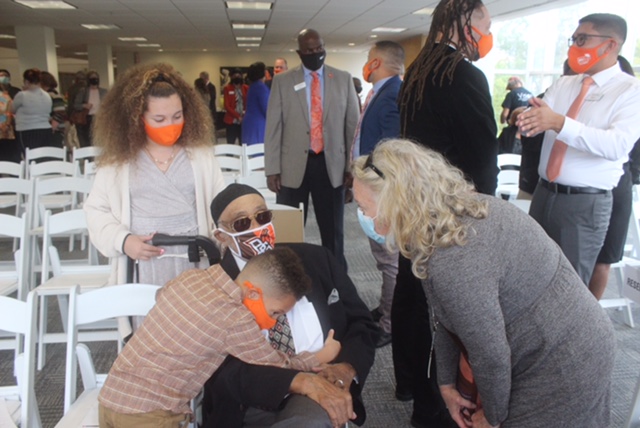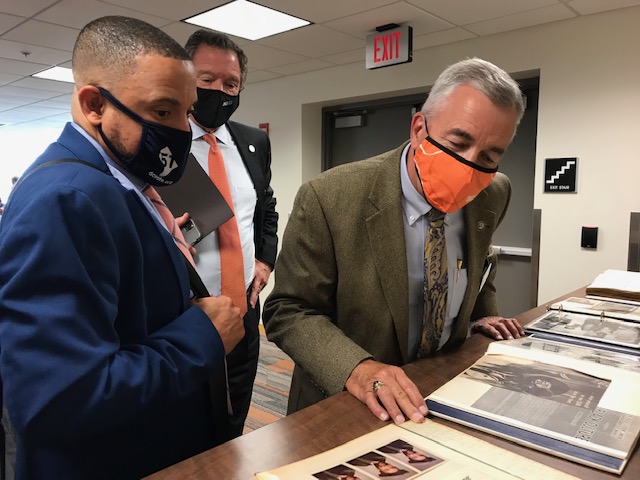By DAVID DUPONT
BG Independent News
Almost a quarter century after Dr. Robert Perry retired from at Bowling Green State University, the programs he set in motion continue to evolve.
Perry, a pioneer in Ethnic Studies at BGSU and nationally, was honored Thursday when the university named the veranda on Shatzel Hall for him. The building houses the School for Cultural and Critical Studies, which includes the Department of Ethnic Studies.
Responding to protests from the Black Student Union, Perry and colleagues established the Ethnic Studies Center in 1972, which in time became the Ethnic Studies major – one of the first in the country.
In 1992, again with Perry’s leadership, BGSU established a cultural diversity course requirement for all students. It was the first such required course in the nation.
“Dr Perry’s work is one of those mile posts of progress in our university’s history,” President Rodney Rogers said at the naming ceremony.
Perry was, Rogers said, the “key leader” in ethnic studies.

Perry, a two-time BGSU graduate, said he was humbled and was quick the share the credit.
He praised the students who demanded “that this institution offer courses where they could learn about non-white history, culture, and politics.”
He credited his colleagues on the faculty, including Ernest Champion and John Scott, and the administrative staff that kept the office moving.
“We did it together,” Perry, 88, said. “I’m so proud of what we accomplished together because it began by listening to the student experience.”
Perry brought a breadth of experience to academia including doing social service in Toledo and serving in the Air Force during the Korean Conflict and the Vietnam War.
For Perry, at 88, the work is not over. These times remind him of the 1950s when he first came to BGSU. They remind him of a later time when he was doing doctoral studies at Wayne State and tanks rolled through the streets of Detroit to quell the urban rebellion.
The ethnic studies center was founded in the wake of the “massacres” of students at Kent State and South Carolina State.
“We need only to point to the continued attacks on ethnic and racial identity and the lived experiences of marginalized groups to realize how important it is to honor the work begun by Bowling Green Black student activists in the 1960s,” Perry said.
“To be clear, white racism is alive and well today,” he said. This is evident the “attacks on local school boards nationwide over critical race theory that permeate the news today.”

The work that Perry and his colleagues started has continued. Two years ago the university created the Division of Diversity and Belonging. Jennifer McCary, the chief diversity and belonging officer, hosted the dedication event.
But at the time of the center’s founding, Perry said, “Few expected it to last more than a couple of years as the civil rights energy was expected to calm down.”
Instead it expanded.
“It is so inspiring to see it continue,” he said.
On Friday morning, the Board of Trustees’ newly formed Diversity and Belonging Committee met to discuss the next development in ethnic studies.
McCary, Vice Provost for Academic Affairs Glenn Davis, and Director for the Center for Women and Gender Equity Kacee Ferrell Snyder made a presentation on a new course BGSU 1914.
The course explores the intersection of democracy and race, and how those issues have played out since the founding of the United States.
Snyder connected the new course, which would meet students’ Cultural Diversity in the United States requirement, to Perry’s work. “This is the next step in continuing that legacy.”
The course, McCary said, does not teach Critical Race Theory, nor is it designed to educate only certain students or make any students feel embarrassed or ashamed*.
It is designed to educate all members of the BGSU community on issues regarding diversity, inclusion and democracy. It will help students discuss race within the context of democracy. Enhance students’ knowledge of the U.S. government and how race has been addressed over the years and consider how these issues are related.
“These are hard questions for 18-year-olds,” Snyder said
The course will focus on getting students to ask questions about these issues and have conversations with their peers.
This semester a working group will create an outline of the pilot course, review Ohio Department of Higher Education guidelines, and identify faculty that will teach the course.
All faculty who teach the course will be required to take the online course “Race and Cultural Diversity in American Life and History” by James Anderson from the University of Illinois. The course is available through Coursera.
A pilot of BGSU 1914 will be taught in Spring, 2022#. The hope is to have 160 students, from first year to senior, in eight sections.
Davis said that the idea was to see how students in different classes respond.
(ED NOTE: *This sentence has been edited for clarity. #The date was originally incorrect.)

